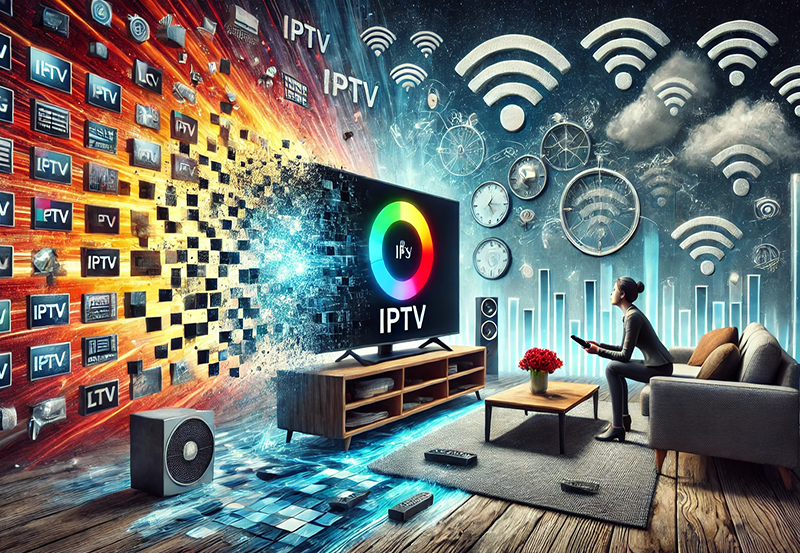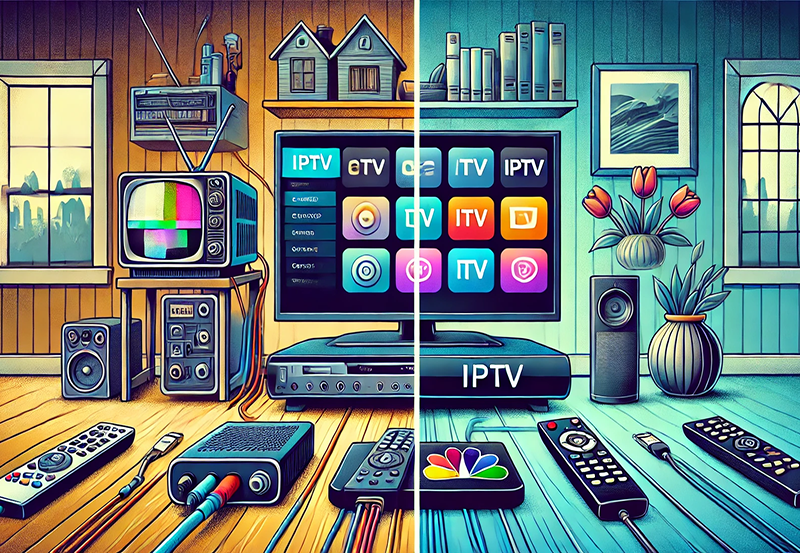In the digital age, the convenience of live TV streaming has transformed the way we consume television content. Yet, as any avid viewer of IPTV on Roku or similar platforms can attest, encountering buffering during peak hours can be frustrating. The buffer wheel seems grinning at you, mocking the experience you crave. Thankfully, there are effective strategies to ensure uninterrupted streaming, particularly during those congestion-packed times. This guide walks you through practical steps and insights—the true expert’s guide to IPTV enjoyment. Buy 1 Year IPTV and Enjoy Unlimited Content
Understanding IPTV and Its Popularity
IPTV, or Internet Protocol Television, is rapidly becoming the go-to choice for television viewers around the world. Its appeal lies in the flexibility and variety of content offered, from live sports to box-set binges, catering to the personalized tastes of a diverse audience. But the surge in demand, especially during peak hours, often results in issues such as buffering, leaving users searching for solutions.
Why is IPTV the Preferred Choice?
The allure of IPTV lies in its ability to offer content on-demand, breaking away from traditional scheduling confines. You can savor your favorite shows on devices like Roku or enjoy live sports all from the comfort of your home. The vast content library and the convenience of watching anything, anytime, anywhere—are what make IPTV so enticing.
Moreover, the cost-effectiveness compared to traditional cable or satellite packages provides users with a wider array of choices at an affordable price. With customized channel offerings tailored to your preferences, it’s no surprise that IPTV is eclipsing conventional television methods.
The Peak Hour Predicament
During peak hours, notably evenings and weekends, an influx of users can stretch IPTV servers to their limits. The resultant slowdown often leads to buffered content, reducing the smooth flow of your favorite show or match. It’s a dance between supply and demand, where finding equilibrium is crucial.
This is especially pertinent for events that draw massive viewers, such as major sports events, reality show finales, or exclusive series releases, when everyone seems to log on simultaneously, vying for bandwidth.
Practical Solutions for Buffering Issues
Facing buffering is akin to battling a monster: frustrating and meddlesome. But, like every monster, it has its Achilles’ heel. Let’s explore some practical strategies to ease or eliminate buffering during peak times.
Optimizing Your Network Connection
The heartbeat of streaming lies in your internet connection. Ensuring a strong, reliable network is paramount. Here are a few tactics to optimize your setup:
- Use an Ethernet cable to connect your streaming device directly to the router for a stable connection.
- Reduce network congestion by limiting the number of devices using the internet simultaneously.
- Consider upgrading to a higher bandwidth plan with your internet provider.
Adjusting Streaming Settings
Your choice of settings can make a significant difference. Manipulating bitrates and resolution can ease the load on your network. Lowering the video quality slightly from 4K to HD can drastically reduce buffering without severely affecting viewing satisfaction.
Many IPTV services feature adjustable settings to buffer ahead of time. Explore these options to find the perfect balance for uninterrupted viewing.
Advanced Techniques for Seamless Watching
For those looking to delve deeper into technical tweaks, additional advanced methods can enhance your IPTV experience.
Utilize VPN Services
Using a VPN can potentially bypass throttling by your ISP, a common cause of reduced bandwidth during peak times. By masking your data, it ensures consistency in streaming speed and quality. Choose a reputable VPN provider known for high-speed connections.
Complicated as it sounds, employing a VPN often yields rewarding outcomes, providing both security and speed to revitalize your IPTV enjoyment without noticeable buffering interruptions.
Upgrade Your Streaming Device
Sometimes, the issue may lie with the hardware rather than the connection. If your device is outdated, consider upgrading to a more current model for enhanced processing power and efficiency. Newer devices often have better compatibility with streaming services, thus minimizing buffering.
Investing in equipment that supports cutting-edge streaming technology ensures you get the best out of IPTV, relishing seamless live TV streaming with fewer hindrances.
DIY Troubleshooting Tips
Before reaching for professional help, there are several DIY fixes you can try at home. These simple solutions might save you time and frustration without the need for expert intervention.
Device Restart and System Updates
Often, a mere restart of your streaming device can resolve temporary glitches, freeing up memory and resetting processes. Ensure your device’s software is always up to date, as updates often include improvements that mitigate common issues like buffering.
Clear Cache Regularly
Your device’s cache can become bloated over time, slowing down processes significantly. Regularly clearing your cache helps maintain optimal device performance. Check online tutorials specific to your device model if you’re unsure how to proceed.
Router Placement and Configuration
The location and setup of your router can considerably affect signal strength. Position it centrally in your home and away from physical obstructions. Adjust the antenna, if possible, for optimal directional coverage. Configuring a dual-band router might separate high-demand streaming from other activities, thus minimizing congestion.
Exploring Future-Proof Streaming Solutions
As technology continues to evolve, so do solutions for a smoother streaming experience. Being aware of emerging trends and tools can place you ahead of the curve in the quest for perfect IPTV streaming.
Embrace New Technologies
Technological advancements like AI-based algorithms can optimize your network and predict congestion points, adjusting streaming quality in real-time to prevent buffering. Technology such as WiGig and other future connectivity standards promises significantly improved internet speeds, making buffering a thing of the past.
Stay Informed about Service Provider Offerings
As IPTV services expand their capabilities, continuously engage with your provider for the latest offerings or infrastructure upgrades. They might offer advanced streaming packages or hardware with premium features. Being proactive about your choices can ensure the zenith of IPTV enjoyment with minimal frustration.
Empowering Yourself as a Viewer
While buffering can be a tedious companion to IPTV streaming, knowledge is power. By implementing strategies and keeping abreast of emerging technologies, you not only combat buffering but also champion a more gratifying viewing experience.
Engage with Streaming Communities
Joining forums or online communities based around IPTV can open doors to insider tips and collective knowledge from fellow users. Learning from shared experiences and troubleshooting tips can guide you in optimizing your streaming setup, unique to your situation.
Keep Experimenting
What works for one viewer might not work for another. Don’t shy away from experimenting with different strategies or settings to find the blend that guarantees optimal viewing for you. The adaptability of IPTV is its strength, offering multiple pathways to a seamless entertainment experience.
FAQs on Minimizing IPTV Buffering

What is the main cause of buffering during peak hours?
The primary cause of buffering during peak hours is network congestion. With many users accessing the same content simultaneously, bandwidth is saturated, leading to a slower data transmission rate.
Can upgrading my router solve buffering issues?
Upgrading to a more powerful router can improve signal strength and bandwidth allocation, which may help reduce buffering. Newer models often have better range and processing capabilities, supporting higher traffic loads efficiently.
Will lowering video quality improve streaming?
Yes, reducing the video quality can decrease the amount of data required per second, alleviating some demand on your network, thus reducing buffering instances. Adjusting bitrate can also foster smoother streaming.
Are there any specific apps to monitor network stability?
There are several applications available that can help monitor your network stability, like Speedtest, NetSpot, and Fast.com. These tools provide insights into your connection speed and can highlight potential issues affecting your streaming experience.
How can a VPN improve my IPTV experience?
A VPN can safeguard your connection by encrypting data and potentially bypass ISP throttling. This can ensure a more stable and consistent streaming experience, though it might not be suited for everyone due to varying results based on location and VPN provider.
Do software updates help reduce buffering?
Absolutely. Software updates typically bring performance improvements and bug fixes which may enhance streaming efficiency and reduce buffering. Regularly update both your device and apps to benefit from these enhancements.
IPTV Troubleshooting 101: The 5 Technical Issues You Need to Know





